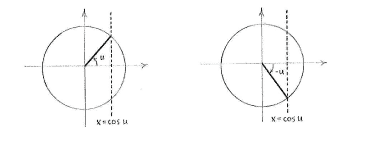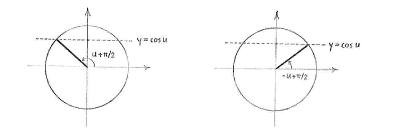Lösung 4.4:7c
Aus Online Mathematik Brückenkurs 1
K |
K (Robot: Automated text replacement (-{{Displayed math +{{Abgesetzte Formel)) |
||
| Zeile 4: | Zeile 4: | ||
So, we start by looking at the equality | So, we start by looking at the equality | ||
| - | {{ | + | {{Abgesetzte Formel||<math>\cos u=\cos v\,\textrm{.}</math>}} |
We know that for fixed ''u'' there are two angles <math>v=u</math> and <math>v=-u</math> in the unit circle which have the cosine value <math>\cos u</math>, i.e. their ''x''-coordinate is equal to <math>\cos u\,</math>. | We know that for fixed ''u'' there are two angles <math>v=u</math> and <math>v=-u</math> in the unit circle which have the cosine value <math>\cos u</math>, i.e. their ''x''-coordinate is equal to <math>\cos u\,</math>. | ||
| Zeile 16: | Zeile 16: | ||
The angles <math>u+\pi/2</math> and <math>-u+\pi/2</math> therefore have their ''y''-coordinate, and hence sine value, equal to <math>\cos u</math>. In other words, the equality | The angles <math>u+\pi/2</math> and <math>-u+\pi/2</math> therefore have their ''y''-coordinate, and hence sine value, equal to <math>\cos u</math>. In other words, the equality | ||
| - | {{ | + | {{Abgesetzte Formel||<math>\cos u = \sin v</math>}} |
holds for fixed ''u'' in the unit circle when <math>v = \pm u + \pi/2</math>, and more generally when | holds for fixed ''u'' in the unit circle when <math>v = \pm u + \pi/2</math>, and more generally when | ||
| - | {{ | + | {{Abgesetzte Formel||<math>v = \pm u + \frac{\pi}{2} + 2n\pi\qquad</math>(''n'' is an arbitrary integer).}} |
For our equation <math>\cos 3x = \sin 4x</math>, this result means that ''x'' must satisfy | For our equation <math>\cos 3x = \sin 4x</math>, this result means that ''x'' must satisfy | ||
| - | {{ | + | {{Abgesetzte Formel||<math>4x = \pm 3x + \frac{\pi}{2} + 2n\pi\,\textrm{.}</math>}} |
This means that the solutions to the equation are | This means that the solutions to the equation are | ||
| - | {{ | + | {{Abgesetzte Formel||<math>\left\{\begin{align} |
x &= \frac{\pi}{2} + 2n\pi\,,\\[5pt] | x &= \frac{\pi}{2} + 2n\pi\,,\\[5pt] | ||
x &= \frac{\pi}{14} + \frac{2}{7}\pi n\,, | x &= \frac{\pi}{14} + \frac{2}{7}\pi n\,, | ||
Version vom 09:01, 22. Okt. 2008
If we want to solve the equation \displaystyle \cos 3x = \sin 4x, we need an additional result which tells us for which values of u and v the equality \displaystyle \cos u = \sin v holds, but to get that we have to start with the equality \displaystyle \cos u=\cos v.
So, we start by looking at the equality
| \displaystyle \cos u=\cos v\,\textrm{.} |
We know that for fixed u there are two angles \displaystyle v=u and \displaystyle v=-u in the unit circle which have the cosine value \displaystyle \cos u, i.e. their x-coordinate is equal to \displaystyle \cos u\,.
Imagine now that the whole unit circle is rotated anti-clockwise an angle \displaystyle \pi/2. The line \displaystyle x=\cos u will become the line \displaystyle y=\cos u and the angles u and -u are rotated to \displaystyle u+\pi/2 and \displaystyle -u+\pi/2, respectively.
The angles \displaystyle u+\pi/2 and \displaystyle -u+\pi/2 therefore have their y-coordinate, and hence sine value, equal to \displaystyle \cos u. In other words, the equality
| \displaystyle \cos u = \sin v |
holds for fixed u in the unit circle when \displaystyle v = \pm u + \pi/2, and more generally when
| \displaystyle v = \pm u + \frac{\pi}{2} + 2n\pi\qquad(n is an arbitrary integer). |
For our equation \displaystyle \cos 3x = \sin 4x, this result means that x must satisfy
| \displaystyle 4x = \pm 3x + \frac{\pi}{2} + 2n\pi\,\textrm{.} |
This means that the solutions to the equation are
| \displaystyle \left\{\begin{align}
x &= \frac{\pi}{2} + 2n\pi\,,\\[5pt] x &= \frac{\pi}{14} + \frac{2}{7}\pi n\,, \end{align}\right. |
where n is an arbitrary integer.


